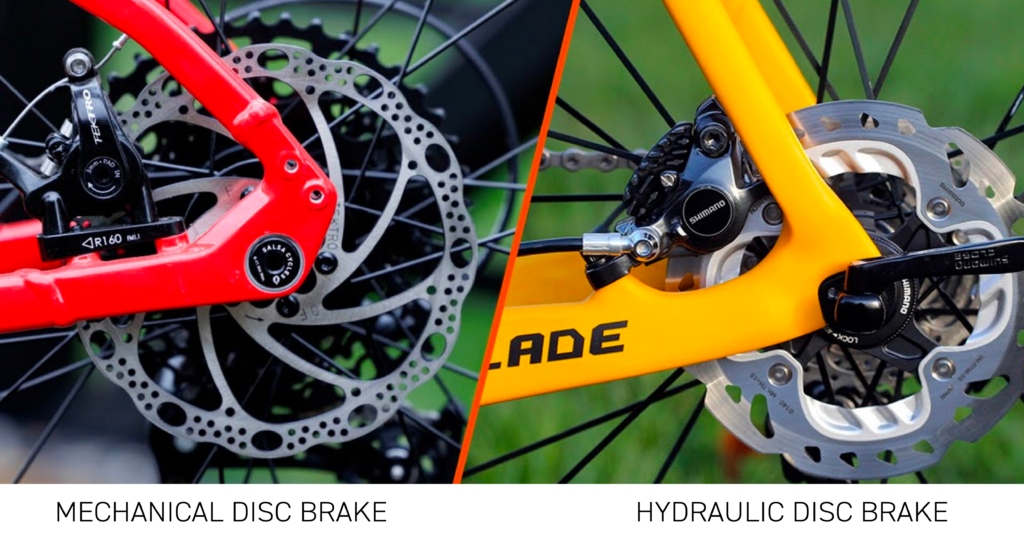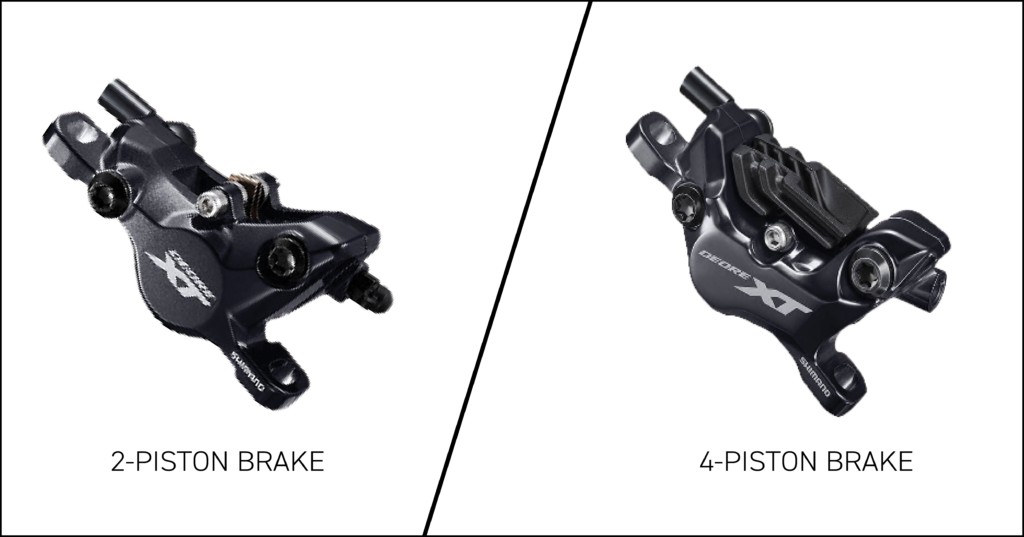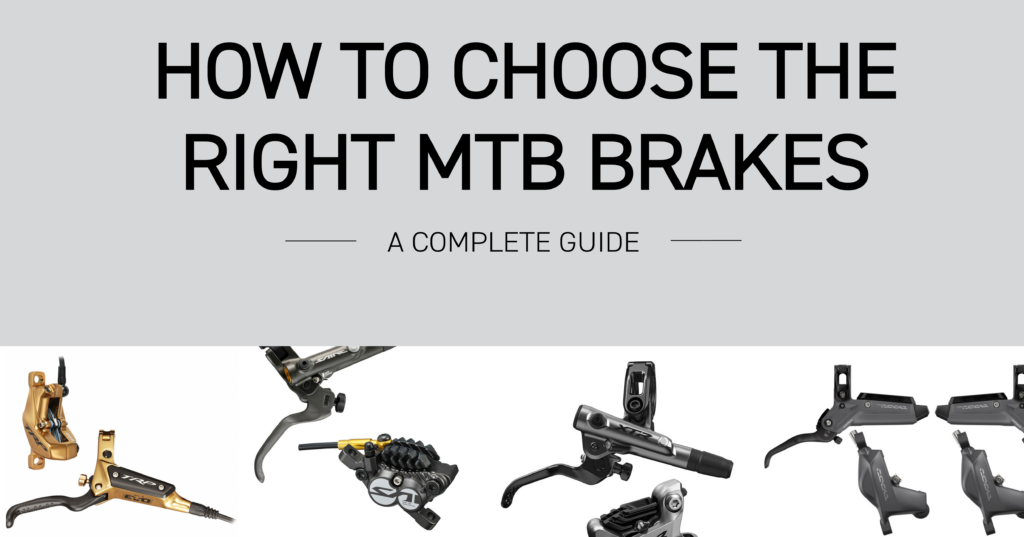How to Choose the Right MTB Brake
How to choose the right MTB brake: Choosing the right mountain bike brakes is crucial for your safety and performance on the trail. There are several types of MTB brakes available, and the choice depends on your riding style, preferences, budget, and more. Here are some factors to consider when choosing the right MTB brakes:
Brake Types:
Disc brakes have become the standard for most modern mountain bikes due to their superior performance, especially in challenging trail conditions. They provide better stopping power and performance in wet conditions compared to rim brakes. Disc brakes can be further categorized into:
Hydraulic Disc Brakes:
These typically provide better modulation, meaning you can control the amount of braking force more precisely. They also require less finger effort and offer consistent performance in varying conditions. However, hydraulic systems may be more complex to maintain and repair.
Mechanical Disc Brakes:
Operate with a cable, similar to rim brakes. They are generally easier to set up and maintain, making them a good option for riders who prefer DIY maintenance. However, they typically offer slightly less modulation compared to hydraulic brakes.

Brake Pads:
Brake pads are a crucial component of the braking system. Different compounds offer varying levels of durability, heat dissipation, and braking performance. Sintered (metallic) pads tend to perform well in wet and muddy conditions, while organic pads might provide better modulation. To find out more about the differences between metal and resin brake pads, you can read our blog post that goes into more depth: METAL VS. RESIN BRAKE PADS – WHAT’S THE DIFFERENCE?
Braking power:
Braking power is a critical consideration when choosing the right mountain bike (MTB) brakes. The ability to control your speed and stop effectively is essential for safety and performance, especially when riding on challenging and varied terrains. A heavier rider, or one carrying a heavy load, may require a more powerful brake than a lighter rider.
Hydraulic Brake Design:
The design of hydraulic disc brakes, including the caliper and master cylinder, plays a role in braking power. Mountain bike brakes typically come in either 2-piston or 4-piston options, which refers to the number of pistons (cylinders) inside the brake caliper that push the brake pads onto the rotor to slow the wheel down. 4-piston MTB brakes are a type of hydraulic disc brake that use four pistons inside the brake caliper to apply pressure to the brake pads, while a 2-piston MTB brake uses two pistons inside the brake caliper. 4-piston brakes will offer better braking power than 2-piston brakes. To read more on the differences between 2-piston and 4-piston brakes, you can read our blog post that goes into more depth: 2 PISTON VS. 4 PISTON MTB BRAKES – WHAT’S THE DIFFERENCE?

Rotor Size:
Choosing the right rotor size is an important consideration when selecting mountain bike (MTB) brakes. The rotor size affects braking power, heat dissipation, and overall braking performance. Here are some factors to consider in relation to rotor size:
Larger Rotors for More Braking Power:
Larger rotors generally provide more braking power. This is because a larger rotor increases the leverage on the braking system, allowing for more effective stopping power. If you ride in demanding conditions, such as downhill or enduro, where strong braking is crucial, larger rotors are often preferred.
Rotor Size Options:
Common rotor sizes for MTB brakes include 160mm, 180mm, and 203mm. The specific size you choose depends on your riding style, preferences, and the type of terrain you frequent. We offer rotors in all three sizes. Click here to shop our full rotor selection.
Downhill and Enduro Riding:
For riders engaging in downhill or enduro riding, larger rotors (180mm or 203mm) are often recommended. These sizes offer more surface area for heat dissipation, which is crucial when descending at high speeds or navigating steep and technical trails.
Cross-Country Riding:
Cross-country riders, who prioritize weight savings and smoother modulation, might opt for smaller rotors (160mm or 180mm). These sizes can provide sufficient braking power for less aggressive riding without adding unnecessary weight to the bike.
Weight Considerations:
Larger rotors are generally heavier than smaller ones. If weight is a significant concern for your riding style, you might lean toward smaller rotors. However, it's essential to find a balance between weight savings and the braking power required for your riding conditions.
Frame and Fork Compatibility:
Ensure that your bike's frame and fork are compatible with the rotor sizes you intend to use. Check for mounting standards (such as IS mount or post mount) and consider any potential clearance issues. For more information on IS and post mounts, you can read out blog post SHIMANO DISC BRAKE ADAPTORS – WHAT’S THE DIFFERENCE?
Rotor Size Mixing:
Some riders choose to mix rotor sizes, using a larger rotor in the front and a smaller one in the rear. This configuration can provide a good balance of power and modulation. However, it's essential to maintain proper brake balance to avoid skidding or loss of control.
Modulation:
Modulation is a crucial factor to consider when choosing the right mountain bike (MTB) brakes. Modulation refers to the ability to control and vary the amount of braking force applied, allowing for precise control in different riding situations. Here are some considerations regarding modulation when selecting MTB brakes:
1. Hydraulic disc brakes typically offer better modulation than mechanical ones.
2. Organic brake pads often provide better modulation compared to metallic (sintered) pads.
3. Smaller rotors can offer better modulation but may generate less overall braking force.
4. The design of the brake lever can influence modulation. Look for brake levers with adjustable reach, allowing you to customize the lever's position to suit your hand size and preferences.
5. Consider the type of terrain you'll be riding on. In technical and challenging conditions, modulation becomes particularly important for navigating obstacles, controlling speed, and maintaining balance.
Weight:
Consider the weight of the brakes, especially if you are focused on building a lightweight bike. Lighter brakes can enhance overall bike performance, but they may come with a trade-off in terms of durability.
Budget:
Your budget will play a significant role in your brake selection. High-end hydraulic disc brakes with advanced features tend to be more expensive. However, there are reliable and effective options available at various price points.
Brand and Reviews:
Stick to reputable brands that are known for producing reliable and high-quality braking systems. Read reviews from other riders to get an idea of real-world performance and durability. We carry many brakes from three of the top brake brands, SRAM & Shimano, and TRP.
Ease of Maintenance:
Consider the ease of maintenance. Hydraulic brakes may require bleeding, and some riders find this process intimidating. Mechanical disc brakes, on the other hand, might be easier to adjust and maintain.
Compatibility:
Ensure that the brakes you choose are compatible with your bike's frame and fork. Check the mounting standards (e.g., IS mount or post mount) and rotor size compatibility.
Terrain and Riding Style:
Tailor your brake choice to your riding style and the type of terrain you frequent. Downhill riders may prioritize powerful brakes with large rotors, while cross-country riders might focus on weight and modulation.
Our Take
In summary, when selecting MTB brakes, consider your riding style, braking power needs, modulation preferences, budget, compatibility, and personal preferences. It may be helpful to consult with a knowledgeable bike shop or experienced rider to help guide your decision.
Need New Brakes?
If you are in need of mountain bike brakes we offer multiple options from SRAM, Shimano, and TRP. Shop our full selection of mountain bike brakes here. Remember that we offer free shipping on all orders over $149CAD. All orders are shipped out within 24 business hours as well.
Spend less and ride the best with TBS Bike Parts.
Related Articles
SHIMANO DISC BRAKE ADAPTORS – WHAT’S THE DIFFERENCE?
2 PISTON VS. 4 PISTON MTB BRAKES – WHAT’S THE DIFFERENCE?
METAL VS. RESIN BRAKE PADS – WHAT’S THE DIFFERENCE?

